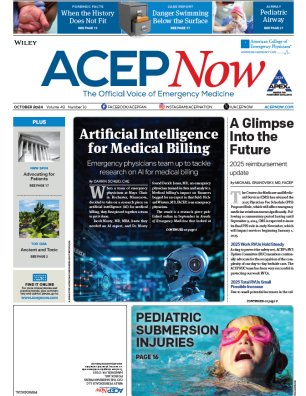Several sources suggest that the overall number of both claims and paid claims has trended down in recent years and that the total indemnities paid have diminished dramatically. However, there are substantial monetary costs (average $22,959, and up to twice that in litigated cases) incurred in simply defending claims, in addition to indemnity payments.
Explore This Issue
ACEP News: Vol 31 – No 11 – November 2012The average duration of claims ranged from 11 to 43 months depending on the type of resolution achieved. Therefore the human costs (time away from practice, stress on the individual physician, the practice, and the family, damage to reputation, increasing liability premiums, perpetual reporting requirements to various agencies, employment discrimination, etc.) are still substantial.
In the ACEP Medical Legal Survey, 60% of sued respondents reported that they had experienced litigation stress. Few felt that they had any preparation or education in dealing with the stress. Almost 90% of all respondents reported that they practice defensive medicine (defined as ordering tests or consultations to avoid potential liability), which is certainly a common response among physicians to litigation or the fear of litigation.
The stress of ongoing or impending malpractice claims can prompt a variety of intrusive feelings. Physicians undergoing litigation stress often feel isolation and sadness or irritability and anger, disbelief, and a sense of betrayal or of being unjustly singled out. They may experience denial, anxiety, insomnia, inertia, or depression, which can be low-level or occasionally debilitating. The onset or exacerbation of physical illness, including gastrointestinal or cardiac symptoms, is not uncommon but is often ascribed to tension, and therefore medical evaluation is typically delayed. Self-treatment is common.
Litigation or medical malpractice stress also typically causes significant immediate changes in practice patterns, all of which are deleterious to good practice and to patient relationships. Sued physicians emotionally distance themselves from patients, whom they may begin to view as potential future litigants. They become less confident in their capabilities, second guessing diagnoses, calling for more consultations, requiring more confirmatory lab tests, and admitting or transferring patients more liberally.
They become much more obsessive in record keeping, which could be viewed as protective except that this often comes at the cost of effectively communicating with patients. It has been shown that physicians who have recently received claims may be more vulnerable to subsequent claims.
Physician litigation stress also frequently results in long-term changes, especially if the physician already suffers from an emotional deficit or is sued early or multiple times in the course of a career. Such physicians are more likely to consider changing practice locations or medical specialty, to consider retiring early, or changing careers to something less stressful. In the worst cases, disability or even suicidality may emerge as a result of medical malpractice stress.
Pages: 1 2 3 4 | Single Page




No Responses to “We Are Not Malpractice Magnets!”